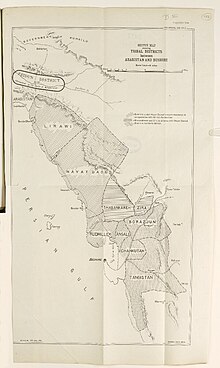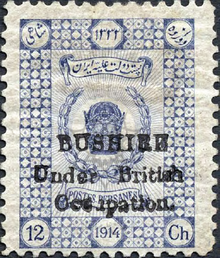| British occupations of Bushehr | |||||||
|---|---|---|---|---|---|---|---|
| Part of Persian campaign (World War I) (Third occupation) | |||||||
 Political map showing different local tribal regions and alliances in the Bushehr area, 1915 | |||||||
| |||||||
| Belligerents | |||||||
| |||||||
| Commanders and leaders | |||||||
|
| ||||||
| Units involved | |||||||
|
| ||||||
| Strength | |||||||
|
Iranian boats:
|
British Equipments: | ||||||
| Iran had officially declared neutrality in the World War I. | |||||||
The British occupations of Bushehr or Bushire under British occupation refers to the three times British forces entered Bushehr and occupied this area in Iran during the rule of the Qajar dynasty, before and during World War I.
Background
According to Encyclopædia Iranica, the British East India Company had a presence in Bushehr since 1763 due to its commercial importance. Later, due to the interference of the Iranian ruler Karim Khan Zand, the Company concentrated on the port of Basra, but following the capture of Basra by Karim Khan Zand, in 1778 the British re-established their commercial base in the Persian Gulf in Bushehr and continued to increase their influence in the Gulf for about a century.
Occupations
First occupation (1838)
The first occupation of Bushehr was in 1838 (1217 SH - 1254 AH) during the reign of Mohammad Shah Qajar, when a British ship anchored in front of Bushehr, and 500 people disembarked and settled in Kuti (one of the old neighbourhoods of the port of Bushehr), where the house of a British person named Ballews was located. This action of the British was to put the Shah in a tight spot to lift the siege of Herat. This led to an uproar in Bushehr, and after that, the people's groups led by Bagher Khan Tangestani and Sheikh Hassan Ale-Osfoor (religious leader of Bushehr) expelled the British from Bushehr.
Second occupation (1856)
When Dost Mohammad Khan, the then ruler of Kandahar and Kabul, captured Herat in 1855, Naser al-Din Shah Qajar ordered an expedition to Herat. Herat was a city of conflict between Iran, the Russian Empire and Britain. With the capture of Herat by Iran, the then British government declared war on Iran. Because the Iranian government was indifferent to Britain's response, Britain attacked Bushehr in 1856 and occupied it in retaliation and to pressure Iran to leave Herat. At that time, Mohammad Karim Khan Kermani incited the people to resist the British occupation by writing a book titled "Naseriyeh".
This occupation ended with the Treaty of Paris in 1857. Iran pledged to withdraw from Herat and recognize Afghanistan, so British troops left Bushehr. On June 12, 1857, while staying in London, Karl Marx wrote an article entitled "The Persian Treaty" and criticized both the clauses of the 1857 Treaty of Paris and Britain for occupying Bushehr and the southern regions.
Third occupation (1915)

Until the middle of the 19th century, British supremacy in the Persian Gulf relied on the development of Bushehr port. But from the end of this century, the opinion of other countries such as the German Empire was attracted towards Bushehr and they opened consular offices in Bushehr. Iran's trade relations with Germany and the purchase of ships from it were unpleasant for Britain, which had maintained its customs status.
According to documents, Wilhelm Wassmuss arrived in Bushehr in 1913 as the second consul of Germany. With the start of the First World War in 1914, the German consulate was activated to confront the British. In this way, Wassmuss had close relations with the nomads of southern Iran, including with Rais Ali Delvari. On the other hand, Iran declared neutrality to avoid entering the First World War. The rivalry between Britain and Germany finally reached its climax with the arrest of two German consular officials in Bushehr by the British forces. The then government of Iran and the people of Bushehr protested this action.
On August 8, 1915, a British expeditionary force (consisting largely of British Indian Army troops) entered Bushehr from land and sea with the support of naval artillery and announced the occupation of Bushehr by issuing a city-wide proclamation. In this announcement, it was stated that Major Arthur Prescott Trevor has taken over all the affairs of the Bushehr government with the position of "Commander of the Military Government on behalf of the British Government". On the other hand, because the Iranian government cannot establish "order and security in the city of Bushehr and its surroundings", Britain was forced to take this action. According to the announcement, this action was "taken by His Majesty's government due to necessity. A necessity due to aboriginal tribes recent unfortunate attack on Bushehr in which two British officers were killed and three soldiers were injured."

Britain's action was the beginning of the series of struggles of the Tangestanis along with the help of Wassmuss against the occupation of Bushehr. One of the noteworthy points in the occupation of Bushehr was that the British sealed the stamps with their desired title. On these stamp it was written: "Bushire Under British Occupation". It is said that until the end of the occupation of Bushehr in October 1915, some types of this stamp were printed.
During this invasion, the British forces disarmed the local Gendarmerie forces of Bushehr, seized three Iranian vessels stationed in the Bushehr port including the Mozaffari frigate, and armed boats named "Azerbaijan" and "Mazandaran". British forces raised the Union Flag over the seat of government of Bushehr (Amiriyeh Building). 14 residents of Bushehr who protested the occupation the day after it commenced were arrested and deported to India.
Aftermath
The command and logistics center of British military operations in Mesopotamia (against the Ottoman Empire) was Bushehr; therefore, the control of this area was very important for the British. The British fortified the entry bottlenecks to Bushehr by installing trenches, guard posts, artillery, and barbed wire.
See also
- Portuguese conquest of Hormuz
- Anglo-Persian capture of Hormuz
- Abadan Crisis
- Treaty of Paris (1857)
- Iran–United Kingdom relations
- British military network in Iran
- Postage stamps of Bushire under British occupation
References
- ^ Amanat, Abbas; Vejdani, Farzin (2012). Iran Facing Others: Identity Boundaries in a Historical Perspective. Palgrave Macmillan. ISBN 9781137013408.
- ^
مشایخی, عبدالکریم. "نقض بیطرفی ایران در جنگ جهانی اول و اشغال بوشهر توسط قوای انگلیس (۸ اوت ۱۹۱۵ م / ۲۶ رمضان ۱۳۳۳ ه.ق)" [Violation of Iran's neutrality in the First World War and the occupation of Bushehr by British forces (August 8, 1915 AD / 26 Ramadan 1333 AH)]. فصلنامه مطالعات تاریخی (in Persian): ۱۱–۲۵.
مؤسسه مطالعات و پژوهشهای سیاسی. سال هشتم (شماره ۳۲): بهار ۱۳۹۰.
- ^
مشایخی, عبدالکریم. "بازخوانی تاریخ معاصر شیوههای انگلستان در کنترل قیامهای ضداستعماری" [Rereading the contemporary history of England's methods in controlling anti-colonial uprisings]. فصلنامه مطالعات تاریخی (in Persian): ۱۴–۱۹.
کانون اندیشه جوان. سال هشتم (شماره ۵۲)، دی ۱۳۸۵.
- ^
یاحسینی, سیدقاسم; جودکی, محبوبه. "تَنگِستانیها" [Tangestanis]. دانشنامه جهان اسلام (in Persian): ۳۲۵–۳۲۸.
بنیاد دائرةالمعارف اسلامی، تهران، جلد هشتم، سال ۱۳۸۳
- ^
آذرنگ, عبدالحسین. "جنگ جهانی اول" [First World War]. دانشنامه جهان اسلام (in Persian).
بنیاد دائرةالمعارف اسلامی، تهران، جلد ۱۱، سال ۱۳۸۶
- ^ "اشغال بوشهر توسط انگلیسىها و آغاز قيام مردم تنگستان (۱۳۳۳ش)" [The occupation of Bushehr by the British and the beginning of the uprising of the people of Tangestan (1333 AH)] (in Persian). Retrieved 26 July 2022.
- هژبریان, حسین. "چاهکوتاهی" [Chah Kutahi]. دانشنامه جهان اسلام (in Persian).
بنیاد دائرةالمعارف اسلامی، جلد ۱۱، سال ۱۳۸۶
- محمدامیر, شیخ نوری. "صدای تاریخ بوشهر" [The voice of Bushehr history]. زمانه (in Persian).
شماره ۲۴، سال ۱۳۸۳
- "تنگستانی باقرخان - دانشنامه جهان اسلام" [Tangestani Baqerkhan - Encyclopaedia of the World of Islam] (in Persian). Retrieved 26 July 2022.
- "ناصریه، در اشغال بوشهر توسط انگلستان - مکارم الابرار" [Naseriyeh, in the occupation of Bushehr by England - Makarem al-Abrar] (in Persian). Retrieved 26 July 2022.
- "The Persian Treaty - Marx & Engels Public Archive". Retrieved 26 July 2022.
- "اشغال بوشهر توسط بریتانیا" [British occupation of Bushehr] (in Persian). Retrieved 26 July 2022.
- "دست درازی انگلیسیها به جنوب ایران" [Reaching out to the south of Iran by the British] (in Persian). Retrieved 26 July 2022.
- "اشغال بوشهر به دست انگلیسیها" [Occupation of Bushehr by the British] (in Persian). Retrieved 26 July 2022.
- "صدمین سالگرد اشغال بوشهر توسط بریتانیا - بیبیسی فارسی" [100th anniversary of British occupation of Bushehr - BBC News Farsi] (in Persian). 7 August 2015. Retrieved 26 July 2022.